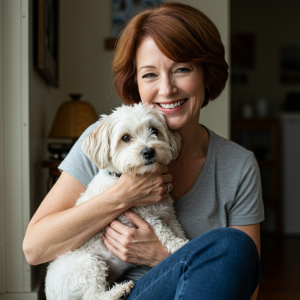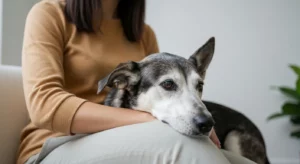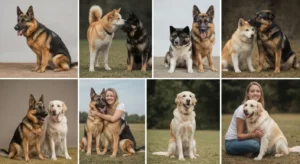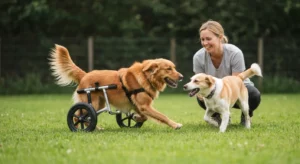July 31, 2025 — As summer celebrations approach, a groundbreaking study is providing new clarity on one of the most distressing issues for pet owners: managing severe pet anxiety and fireworks. Research published this month in the esteemed Journal of Veterinary Behavior: Clinical Applications and Research reveals that the most effective way to help fearful pets is not a single product or trick, but a multi-layered strategy combining environmental management, behavioral techniques, and proactive veterinary care. The findings challenge the common “one-size-fits-all” advice and offer an evidence-based roadmap for millions of concerned owners.
The comprehensive two-year investigation, known as the “Canine Acoustic Fear Response (CAFR) Intervention Study,” was conducted by a team at the prestigious Center for Companion Animal Behavior Studies at the University of Pennsylvania School of Veterinary Medicine. Researchers systematically analyzed the efficacy of various common interventions on over 400 dogs with a documented history of noise phobia. The study measured physiological stress markers, including heart rate variability and salivary cortisol levels, alongside detailed behavioral reports from owners, to create the most complete picture to date of what truly works.
Groundbreaking Study Reveals Most Effective Strategies for Fireworks Fear
For years, the advice for managing a pet’s fear of fireworks has been a fragmented collection of suggestions, from compression vests to calming music. The CAFR study sought to bring scientific rigor to the topic, testing these methods both in isolation and, crucially, in combination.
“We saw a clear and desperate need for evidence-based guidelines,” stated Dr. Elena Vance, a veterinary behaviorist and the study’s lead author. “Owners are bombarded with marketing for countless products, often trying one thing, seeing it fail, and then feeling helpless. Our goal was to determine not just which tools are effective, but how to strategically layer them to create a powerful synergistic effect. The results point toward a proactive, holistic approach as the gold standard for care.”
The study’s most significant finding was the “synergy effect.” No single intervention—whether a pheromone diffuser, a compression vest, or a calming supplement—provided more than a modest reduction in stress when used alone. However, when owners combined two or three specific strategies, such as creating a sound-proofed “safe zone” while also using a vet-prescribed anxiolytic, the observed reduction in both physiological and behavioral signs of fear was profound. Some combinations reduced stress markers by over 70% compared to control groups.
The Critical Importance of Timing and Sound
Another pivotal discovery was the power of proactive management. The research demonstrated a stark difference in outcomes between owners who implemented calming strategies hours before the fireworks began and those who reacted once their pet was already distressed. Interventions like pheromone diffusers and sound masking were significantly more effective when initiated in a calm environment, well in advance of the first firework.
“The data unequivocally shows that once the animal’s fight-or-flight response is fully activated, it is incredibly difficult to de-escalate,” Dr. Vance explained. “The key is to manage the environment and the pet’s emotional state *before* the panic sets in. Prevention is exponentially more effective than intervention.”
The study also produced surprising results regarding sound management. While many owners use “white noise” to drown out external sounds, the CAFR study found that “brown noise,” which contains lower-frequency sounds, was superior at masking the deep, concussive booms of fireworks. Furthermore, specific classical music arrangements, particularly those heavy in cello and bassoon, were shown to lower heart rates more effectively than generic “calming pet music” playlists.
The Role of Veterinary Medicine and a Unified Approach
The research also solidified the role of modern veterinary medicine in managing severe cases of pet anxiety and fireworks. Fast-acting, situational medications like dexmedetomidine oromucosal gel (Sileo) and trazodone were highly effective, but the study emphasized they are not a “magic bullet.” Their greatest efficacy was observed when used as part of a broader behavioral and environmental plan—helping to lower the “emotional temperature” enough for other strategies, like offering a high-value chew toy, to work.
Dr. Marcus Thorne, a board-certified veterinary behaviorist at the Animal Behavior Clinic of Boston who was not involved in the research, called the study a landmark achievement for companion animal welfare.
“The CAFR study is a game-changer because it provides the data to back up what many behavior specialists have long suspected: a multi-modal plan is essential,” Dr. Thorne commented. “It moves the conversation with owners from ‘you could try this’ to a confident, evidence-based protocol. This research gives veterinarians and owners a clear, prioritized action plan that can dramatically improve a pet’s quality of life during these incredibly stressful events.”
While the study focused on canines, experts like Dr. Thorne note that the core principles—proactive management, environmental control, and veterinary consultation—are highly applicable to cats and other pets who suffer from noise phobias.
What This New Research Means for You: An Action Plan for Fireworks Season
The findings from the CAFR study can feel academic, but they translate into a clear and powerful set of actions you can take to protect your pet. Instead of guessing, you can now build a strategy based on scientific evidence. This plan moves beyond a single tip and helps you create a comprehensive defense against the fear and stress caused by fireworks. Follow this step-by-step guide to create a fortress of calm for your companion.
-
Step 1: The Proactive Consultation — Plan Before the Panic
The study’s emphasis on proactive care and the effective use of medication makes this the non-negotiable first step. Schedule an appointment with your veterinarian at least two to three weeks before any anticipated fireworks events (like the Fourth of July or New Year’s Eve). This is not a conversation to have the day before.
What to discuss with your vet:
- Situational Anxiety Medications: Ask about FDA-approved, fast-acting medications designed for noise phobia, such as Sileo, or other commonly prescribed options like trazodone or gabapentin. Discuss proper dosage, timing for administration (the study confirms earlier is better), and any potential side effects. Your vet will ensure your pet is healthy enough for these options.
- Safe Supplements: If your pet’s anxiety is mild, or if you want to add another layer of support, ask about evidence-backed nutritional supplements. Products containing L-Theanine, L-Tryptophan, or hydrolyzed milk proteins have shown calming effects. Your vet can recommend reputable brands and safe dosages.
- Underlying Health Issues: Sudden noise sensitivity can sometimes be linked to pain or other medical conditions. A check-up can rule out other factors that might be exacerbating your pet’s fear.
-
Step 2: Fortify the Environment — Create a “Sensory Safe Room”
Based on the study’s findings on environmental management, your goal is to create a sanctuary that blocks out the sights and sounds of the fireworks. This should be done hours before the event begins.
How to build your safe room:
- Location: Choose the most insulated, interior room in your home. A walk-in closet, a basement, or a bathroom with no windows is ideal.
- Block the Light: Frightening flashes of light can be just as scary as the booms. Use blackout curtains, cardboard, or heavy blankets to completely cover any windows in the room.
- Master the Sound: As the CAFR study revealed, the right kind of sound is crucial. Use a speaker to play brown noise (easily found on YouTube or music streaming services) at a moderate volume. Brown noise’s low-frequency rumble is more effective at masking explosions than the higher-pitched hiss of white noise. Start the sound an hour or two before the fireworks are expected to begin.
- Introduce Calming Scents: The research confirms that pheromone diffusers, like Adaptil for dogs or Feliway for cats, are most effective when started early. Plug one in the designated safe room at least 24-48 hours ahead of time to allow the calming pheromones to permeate the space.
-
Step 3: Implement Calming Tools — Pressure, Comfort, and Distraction
Once the environment is prepared, focus on your pet’s direct physical and mental comfort. The study showed that these tools work best when introduced while the pet is still calm.
- The Power of Pressure: Anxiety-reducing vests (like the ThunderShirt) apply gentle, constant pressure to the pet’s torso, a technique known as Deep Pressure Touch, which has a calming effect on the nervous system. For best results, conduct “practice runs” on calm days. Put the vest on your pet for 10-15 minutes and associate it with a treat or gentle praise, so they don’t link it directly to the scary event.
- Provide Positive Distractions: A key part of the multi-modal approach is giving your pet’s brain something else to do. A long-lasting, high-value food puzzle can work wonders. Prepare a Kong stuffed with frozen peanut butter (xylitol-free) or wet food, or a LickiMat smeared with yogurt. Introduce this special treat just as you are settling into the safe room, before the fireworks start. Licking is a self-soothing behavior for both dogs and cats.
- Familiar Comforts: Make sure the safe room contains your pet’s favorite bed, a blanket that smells like you, and a few familiar toys.
-
Step 4: Master Behavioral Counter-Conditioning (The Long-Term Fix)
While the above steps are for managing acute fear on the night of the event, the ultimate goal is to change your pet’s underlying emotional response. This technique, called counter-conditioning, is a long-term project that should be done during the off-season, not during a live fireworks event.
How to begin:
- Find a high-quality audio recording of fireworks online.
- During a quiet time of day, play the sound at a barely audible volume—so low that your pet doesn’t react at all.
- While the sound is playing, give your pet an incredibly high-value treat, like small pieces of cooked chicken or cheese. The goal is to build an association: faint boom sound = amazing snack appears.
- Keep sessions short (1-2 minutes) and positive.
- Over many weeks or months, you can very slowly increase the volume. If at any point your pet shows fear, you’ve gone too fast. Stop, and return to the last successful volume in your next session.
Important: This process requires patience and should never be rushed. For severe phobias, it is best undertaken with guidance from a certified professional dog trainer or veterinary behaviorist.
-
Step 5: Your Role on the Night — Be a Calm Anchor, Not an Amplifier
A pet’s anxiety can be amplified by their owner’s reaction. Your calm demeanor is a crucial part of the management plan. During the fireworks, your job is to be a source of quiet confidence.
- Do Not Punish: Never scold or punish a pet for showing fear (panting, whining, hiding). This will only increase their anxiety and damage their trust in you.
- Avoid Excessive Coddling: While it’s natural to want to soothe your pet, frantic cooing and excessive petting (“It’s okay! You’re okay! Poor baby!”) can signal to your pet that there is, in fact, something to be afraid of.
- Be Present and Neutral: The best approach is to act as normally as possible. Settle into the safe room with your pet and a book or some quiet music. If your pet seeks you out for comfort, offer slow, gentle, long strokes of petting. Speak to them in a calm, neutral tone. Your steady presence tells them that everything is under control.
By embracing this evidence-based, multi-layered strategy, you can move from feeling helpless to empowered, providing your pet with the comprehensive support they need to weather the storm of fireworks season safely and with significantly less stress.












